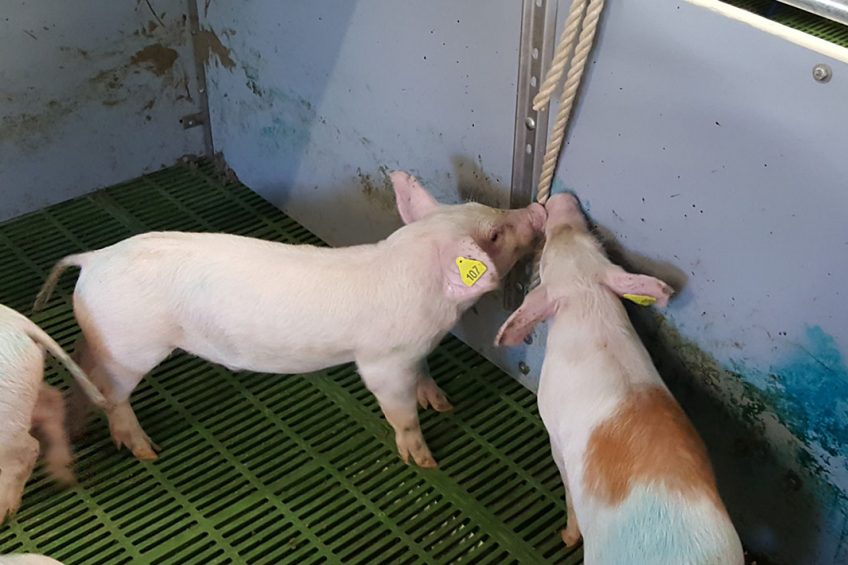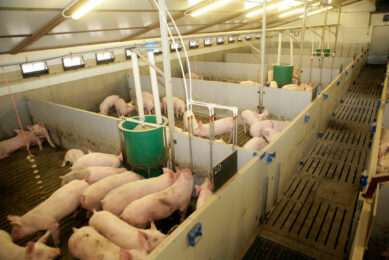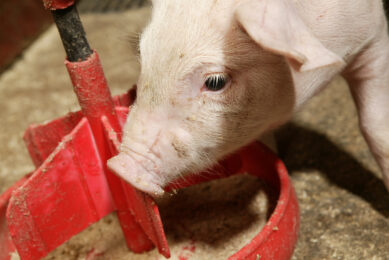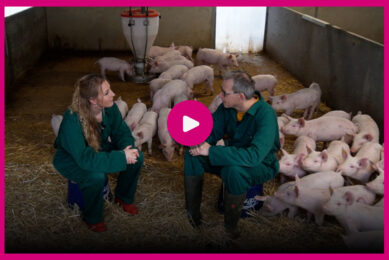What to do when tail biting occurs?

Almost all conventional pig producers will be familiar with tail bitten pigs. It’s called a tail biting outbreak when biting leads to multiple victims per pen, or even spreads throughout the barn. Outbreaks are hard to stop – here is how it is possible to overcome an outbreak successfully.
Tail-bitten pigs are often noticed only at an advanced stage, when there is shortening of the tail. At this stage it is likely that most other pigs in the pen have noticed the blood and been attracted to it. That may motivate them to bite and to create new victims.
Ideally, tail biting is noticed at an early stage, before there is blood on the tail and before the tail length is reduced. This can be through either noticing the biter or noticing the victim. When a pig is repeatedly biting tails, the pig can be observed for ten to 15 minutes to see if it continues biting. If this is the case it might be better to remove the potential problem causer.
Tail posture as indicator
Victims can be recognised at an early stage by looking at tail posture. A tail almost permanently tucked between the legs indicates it is being bitten. A briefly tucked tail can, however, be in response to other social interactions such as displacement. A good time to check tail posture is at the feeder. If the feeding is synchronised, it is easy to check all tails together. Even at an individual feeding station, if pigs are constantly seen with tucked tails when feeding, there may be a biting problem in the pen. A tucked tail should be inspected closely; if injuries are present, then it is better to act immediately rather than wait until it gets worse.

What to do?
Action to address tail biting can be through providing distraction to the group or by removing biters or victims when it is more severe. Almost anything can be used to distract pigs, but they easily lose interest. It is therefore more important to change enrichment regularly than to necessarily have the best type of enrichment. However, enrichment should be safe for the animals and not pose risks for food safety.
Good enrichment materials for pigs are chewable, destructible and edible and can be manipulated by multiple pigs at the same time. Loose materials such as straw, hay and sawdust are most used by pigs, but if the housing limits the provision of these, there are other alternatives. Examples are ropes, large feed pellets (beetroot pellets), soft rubber hoses and jute sacks (burlap sacks).

Using a step-wise protocol
Straw is one of the best materials to occupy pigs. However, for several reasons straw may not be a suitable option or possibility, especially on fully slatted floors. In Ireland about 80% of farms have fully slatted floors. A recent study conducted on a farm in Ireland showed that tail-biting outbreaks can still be effectively reduced using a set protocol. In this protocol three types of intervention were used in a random order:
A. Putting three ropes in a pen of 12-14 pigs
B. Removing the victim
C. Removing the biter.
If after 72 hours blood was detected on one of the pigs in the pen, then the next step was taken. When an option was applied but was not successful, then the next one was applied until all three options had been used. Victims or biters that had been removed were later introduced back in the group as described in the protocol in the box. This resulted in no overt aggression between the pigs when the removed pigs were reintroduced to the original group.
Figure 1 – Step wise plan for overcoming tail biting problems in a pen.

80% of outbreaks can be solved
The study showed that 80% of severe tail-biting outbreaks could be stopped, even when removed pigs are reintroduced to their original groups. Adding ropes could shorten the duration of an outbreak, since it may take longer to remove and reintroduce pigs. Removing victims or biters was as effective as adding ropes in stopping an outbreak. All pigs were reintroduced to their original groups, which saved the need to have extra space to permanently house removed pigs. Based on the outcomes, the following stepwise plan was recommended (see Figure 1).
Figure 2 – The chance of reducing a tail biting outbreak ‘likelihood of success’ depends on the number of victims and biters per pen.

The need to respond quickly
The results also showed the importance of responding quickly to the occurrence of tail biting. The chance of successfully reducing a tail-biting outbreak depends on the number of affected pigs in the pen. Figure 2 shows that if more than 50% of the pigs are victims of tail biting, the chance of success in overcoming the outbreak can still be around 60%. But if 33% of pigs are biters, then the chance of stopping the outbreak is only 30%. Thus, the more biters in the pen, the smaller the chance that the outbreak can be stopped.
| How to remove and reintroduce pigs from a group? 1. Determine which pig to remove to gain most benefit. 2. Remove the selected pig together with at least one other pig. 3. Write down the pen number from which they are removed and date of removal. 4. Provide a recovery pen without mixing with other unfamiliar pigs. 5. When the pigs have recovered, or at least within seven days, return the pigs together to the original pen. 6. Provide ropes in the pen at the time of reintroduction. 7. Use scent marking spray such as diluted Dettol when pigs are returned. |
Have a tail-biting first aid kit
This protocol worked successfully at the farm, which is a conventional farm with fully slatted floors. This does not mean that the protocol will be successful under different conditions. We encourage others to try it but to have other safety measures ready as well. We recommend having a stock of different enrichment objects and products that are directly available whenever an outbreak occurs. Such a ‘tail-biting first aid kit’ can include ropes, straw, toys, large feed pellets (beetroot pellets), rubber hoses and jute sacks (burlap sacks).











